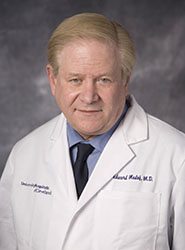M. Edward Medof, MD, PhD

M. Edward Medof, MD, PhD (secondary appointment)
Professor of Pathology, Medicine, and Ophthalmology, Case Western Reserve University
Research Interests
Protection of self cells is conferred principally by intrinsic cell surface regulators. These molecules are the decay-accelerating factor (DAF or CD55), membrane cofactor protein (MCP or CD46), and membrane inhibitor of reactive lysis (MIRL or CD59). DAF dissociates C3 convertases (C4b2a and C3bBb) that assemble on self cells and MCP promotes the cleavage of residual C4b and C3b fragments. CD59 prevents the uptake of autologous C9 by self cell-bound C5b-8 and subsequent formation of lytic membrane attack complexes (MAC). The three proteins differ from the C3b receptor (CR1 or CD35), an extrinsic regulator of C3 convertases that are generated on immune targets, i.e. bacteria or immune complexes.
Research Projects
Previous research in the lab has included:
- Elucidation of the function of immune adherence receptors (CR1) on red blood cells and original description of the red cell immune complex clearance system.
- Discovery that CR1 plays an essential role in the generation of C3dg, the C3 fragment that activates B cells.
- Initial proposal of the concept that two sets of cell-associated complement regulators, i.e. intrinsic and extrinsic, exist.
- Discovery, purification and characterization of DAF or CD59, the regulator which distinguishes self from non-self.
- Characterization of DAF's function in disabling autologous C3 and C5 convertases on self cell surfaces.
- Original preparation of anti-DAF mAbs and analyses of the tissue distribution of surface and soluble DAF proteins in body fluids.
- Clarification of how DAF and MCP cooperate in controlling self cell associated C3/C5 convertases.
- Cloning of DAF cDNA.
- Documentation of the relationship of DAF and CD59 deficiency to the complement sensitivity in the hemolytic disorder, paroxysmal nocturnal hemoglobinuria (PNH).
- Demonstration that DAF is attached to cell membranes by a glycosylphosphatidylinositol (GPI)-anchor.
- Determination that the biochemical defect in affected PNH cells resides in GPI anchor synthesis.
- Characterization of the mammalian intracellular GPI-anchor assembly pathway in the ER.
- Cloning of the GPI transamidase that provides for GPI transfer to proproteins.
- Localization of the biochemical/genetic step that underlies defective GPI synthesis in PNH.
- Characterization of genetic alterations in affected cells of different PNH patients.
- Characterization of the signals in nascent proproteins which direct GPI attachment.
- Initial description and development of the technique of protein engineering or "painting" of cells with GPI reanchored proteins as an alternative to gene transfer for multiple purposes including the production of tumor cell vaccines.
- Preparation of DAF knockout and PNH knockout mice.
- Clarification of the mechanism of acetylcholine receptor loss in myasthenia gravis.
- NMR 3D structural characterization of DAF.
- Mapping of DAF's active site(s) by substitution mutagenesis.
- Discovery of the role of local complement synthesis of antigen presenting cell, T-cell partners in T-cell costimulations.
- Discovery of the role of C3a and C5a receptors in cell viability and cell growth.


